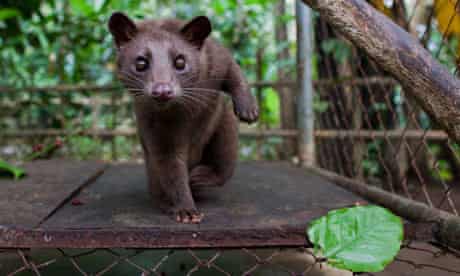Civet coffee is a type of coffee that's made from coffee beans which are excreted whole in the droppings (excrement/poop) of the Asian palm civet.
Kopi luwak comes from the civet. Kopi luwak coffee is the name of the coffee made from the beans found in the poop of the Asian palm civet.
The type of coffee depends on the variety of beans the civet eats. It may feed on beans from the arabica coffee plant, the robusta, or any other coffee plant available to it.
Civet coffee has more to do with the process it goes through, although many people prefer the flavor when it's made from excreted arabica beans.
The droppings are collected and the coffee beans are washed, roasted, ground and then brewed to produce what has become the world's most expensive coffee.
How is civet coffee made?The Asian palm civet eats ripe coffee cherries. After a digestion process of around 24 hours, the undigested coffee beans are excreted in the civet's poop.
The beans are collected and washed. At this time any remnants from the coffee cherries are removed.
The beans are then dried, roasted, ground and brewed.
Is civet coffee safe to drink?
The coffee is said to be safe to drink because the germs would be eliminated during the washing and roasting process.
Why is Civet Coffee So Expensive?
Civet coffee is so expensive because who wants to gather cat poop and pick coffee beans out of it?
the high price seems to come from the “specialty” nature of the coffee. It started off being collected from the droppings of wild civets. That would take a long time to find and to accumulate.
There is also the fact that some people believe it's a superior coffee because of the process it goes through inside of the civet.
Wild civets only eat the ripest coffee cherries (which make the best coffee) which ferment in their digestive tract. During this process of around 24 to 36 hours enzymes break down some of the beans' proteins – altering the taste and chemical composition of the end product.
Sounds pretty sensational, right? So, the rarity of supply and the sensational nature of the “quality coffee” claims result in a hefty price tag.
12 interesting facts you may have never heard about Asian palm civets
- Asian palm civet can reach 21 inches in length (not including the tail that is 19 inches long) and 3 to 10 pounds of weight.
- Asian palm civet does not have rings on the tail.
- Asian palm civet is active during the night (nocturnal animal).
- Asian palm civet is an omnivore. The civet eats ripe coffee cherries, mangoes, rambutan, and other fruit.Its diet is based on rodents, lizards, snakes, frogs, eggs, insects, fruit.
- Asian palm civet spends part of its life on the ground and other parts on the trees.
- Asian palm civet can climb on the trees and house gutters with ease thanks to sharp claws on the feet.
- Predators of Asian palm civets are tigers, leopards, large snakes, and crocodiles.
- Asian palm civet is a solitary creature.
- Asian palm civets can mate all year round.
- Asian palm civet can survive 20 years in the wild and 22 years in captivity.




0 Comments